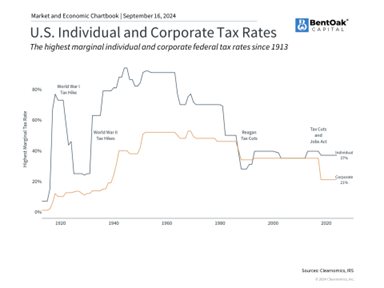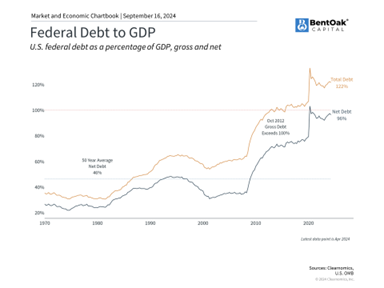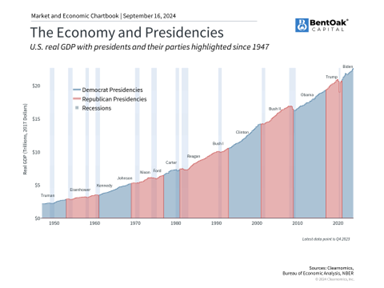With less than two months until the presidential election, the policy platforms of President Donald Trump and Vice President Kamala Harris are gradually coming into focus. Through speeches and debates, each candidate is outlining their campaign platforms and how they would approach changes to existing policies. For investors, perhaps the most scrutinized area is taxes, and there are concerns over how changes to tax rates could impact both Wall Street and Main Street. So, how can investors filter out the noise and keep an election perspective as we approach election day?
Maintaining an Election Perspective This Season

Tax policy is complex, making it essential to work with a trusted advisor. In addition, both candidates’ platforms are still subject to change despite the short timeline until election day. While it’s impossible to cover all the details here, many of the key differences on taxes between the candidates and their parties come down to the future of the Tax Cuts and Jobs Act (TCJA).
Before diving into the details, it’s essential to maintain an election perspective around tax policy, which can often be politically charged. Taxes are intertwined with politics and reflect our polarized political climate. Regardless of which side of the aisle we might be on and what our personal preferences may be, it’s important to stay objective so we can clearly focus on our financial goals.
While taxes have a direct impact on households and companies, they do not always have a straightforward effect on the overall economy and stock market. This is because taxes are just one factor influencing growth and returns. Many deductions, credits, and strategies can reduce the statutory tax rate, and spending and investment patterns often adjust to work around taxes. Put simply, lower taxes don’t guarantee an economic boom, and higher tax rates don’t necessarily trigger a crash.
Additionally, election rhetoric and actual policies can be quite different. Candidates often make promises based on their political leanings that may not fully materialize once in office. Even once a candidate is elected, Congressional partnership and approval is still required to pass new tax laws. Historically, the president’s party tends to lose seats in Congress in their second term, and their approval rating tends to decline. This process can alter or water down initial proposals.
For example, during the 2016 presidential campaign, President Trump promised a complete overhaul of the tax system. While the Tax Cuts and Jobs Act was a significant change to the tax code, it also retained many existing elements. Similarly, President Biden criticized the TCJA during the 2020 election cycle and discussed raising taxes on high income earners and corporations. While the Inflation Reduction Act of 2022 did impose a 15% minimum corporate tax rate, this is far from the sweeping changes discussed during the election.
The Future of the Tax Cuts and Jobs Act and National Debt is Uncertain

The fact is, tax rates have been historically low for decades. Even if there are no changes in the next presidential term, with the federal debt continuing to expand, many economists worry that taxes will have to rise to close the gap in the future.
The TCJA took effect in 2018 and included reducing individual income tax rates with the highest rate declining from 39.6% to 37%, nearly doubling the standard deduction, dropping the corporate tax rate from 35% to 21%, and implementing a territorial tax system for corporations. The TCJA also lowered estate taxes, eliminated personal exemptions, and adjusted several other deductions and credits.
As discussed above, the Inflation Reduction Act of 2022 introduced a 15% minimum tax on large corporations with annual profits over $1 billion. It also implemented a 1% excise tax on stock buybacks for publicly traded companies.
Unless action is taken by the president and Congress, many provisions of the TCJA will expire for the 2026 tax season, creating a so-called “tax cliff.” This makes taxes especially contentious this election season. Here are some of the items the candidates are discussing:
- Trump proposes cutting corporate taxes further from 21% to 15% for some companies, including manufacturers who make their products domestically. Harris is in favor of increasing the corporate tax rate to 28%, in line with President Biden’s position.
- Trump has discussed extending the TCJA’s individual tax rates, but specifics are still unclear. Harris supports allowing the top marginal rate to revert to 39.6%.
- Harris proposes raising the capital gains rate from 20% to 28%. Along with an increase in the “net investment income tax” introduced with the Affordable Care Act, the top capital gains rate would rise to 33%, the highest since 1978.
- Both candidates propose new enhanced child tax credits and not taxing tips. Trump has discussed eliminating taxes on Social Security for seniors.
- Harris proposes expanding the startup expense deduction from $5,000 to $50,000 and $25,000 in support of first-time homebuyers making down payments.
- Harris proposes a new tax on unrealized capital gains for those worth $100 million or more. Such a tax would be historic. The recent Moore v. United States case in the Supreme Court loosely touched on this by allowing a provision in the TCJA that imposed a one-time tax on unrepatriated foreign earnings.
The Economy Has Grown Under Both Parties

Unfortunately, the annual budget deficit remains high and the national debt is likely to grow regardless of who occupies the White House. While studies on the matter differ and should be taken with a grain of salt, many suggest that either candidate would add trillions to the debt in the coming years.
However, it’s also the case that the economy has grown over history under both political parties. As discussed earlier, it’s important to remember that who occupies the White House is not the most important factor for the economy and markets, regardless of how counterintuitive that may seem. Policy changes tend to be gradual due to checks and balances in our political system. Perhaps more importantly, neither candidate is proposing a return to pre-Reagan era tax levels when the top marginal rates reached as high as 94%.
So, while taxes do play an important role in financial plans, they do not necessarily impact investment portfolios and economic growth the way some might imagine. Investors should continue to work with a trusted advisor and focus on their long-term goals this election season. By maintaining a longer-term perspective and avoiding politically driven decisions, investors can better position themselves for success across the evolving political landscape.
Bottom Line: Keeping an Election Perspective
As the election season heats up, it’s important for investors to maintain perspective amid heightened political rhetoric and divergent economic proposals from the candidates. While Trump and Harris may propose changes to the tax code, it’s important to maintain objectivity when crafting financial plans.
The opinions voiced in this material are for general information only and are not intended to provide specific advice or recommendations for any individual.
Investing involves risk including loss of principal. No strategy assures success or protects against loss.
The economic forecasts set forth in this material may not develop as predicted and there can be no guarantee that strategies promoted will be successful.
This information is not intended to be a substitute for individualized tax advice. We suggest that you discuss your specific tax situation with a qualified tax advisor.
Past performance may not be indicative of future results. Different types of investments involve varying degrees of risk. Therefore, it should not be assumed that future performance of any specific investment or investment strategy (including the investments and/or investment strategies recommended and/or undertaken by BentOak Capital [“BentOak”]), or any non-investment related services, will be profitable, equal any historical performance level(s), be suitable for your portfolio or individual situation, or prove successful. BentOak is neither a law firm, nor a certified public accounting firm, and no portion of its services should be construed as legal or accounting advice. Moreover, you should not assume that any discussion or information contained in this document serves as the receipt of, or as a substitute for, personalized investment advice from BentOak. Please remember that it remains your responsibility to advise BentOak, in writing, if there are any changes in your personal/financial situation or investment objectives for the purpose of reviewing/evaluating/revising our previous recommendations and/or services, or if you would like to impose, add, or to modify any reasonable restrictions to our investment advisory services.
Please remember to contact BentOak Capital (“BentOak”), in writing, if there are any changes in your personal/financial situation or investment objectives for the purpose of reviewing/evaluating/revising our previous recommendations and/or services, or if you want to impose, add, to modify any reasonable restrictions to our investment advisory services, or if you wish to direct that BentOak to effect any specific transactions for your account. A copy of our current written disclosure Brochure discussing our advisory services and fees continues to remain available upon request or at www.bentoakcapital.com.
Securities offered through LPL Financial, Member: FINRA/SIPC. Investment advice offered through BentOak Capital, a registered investment advisor and separate entity from LPL Financial.
Copyright (c) 2024 Clearnomics, Inc. All rights reserved. The information contained herein has been obtained from sources believed to be reliable, but is not necessarily complete and its accuracy cannot be guaranteed. No representation or warranty, express or implied, is made as to the fairness, accuracy, completeness, or correctness of the information and opinions contained herein. The views and the other information provided are subject to change without notice. All reports posted on or via www.clearnomics.com or any affiliated websites, applications, or services are issued without regard to the specific investment objectives, financial situation, or particular needs of any specific recipient and are not to be construed as a solicitation or an offer to buy or sell any securities or related financial instruments. Past performance is not necessarily a guide to future results. Company fundamentals and earnings may be mentioned occasionally, but should not be construed as a recommendation to buy, sell, or hold the company’s stock. Predictions, forecasts, and estimates for any and all markets should not be construed as recommendations to buy, sell, or hold any security–including mutual funds, futures contracts, and exchange traded funds, or any similar instruments. The text, images, and other materials contained or displayed in this report are proprietary to Clearnomics, Inc. and constitute valuable intellectual property. All unauthorized reproduction or other use of material from Clearnomics, Inc. shall be deemed willful infringement(s) of this copyright and other proprietary and intellectual property rights, including but not limited to, rights of privacy. Clearnomics, Inc. expressly reserves all rights in connection with its intellectual property, including without limitation the right to block the transfer of its products and services and/or to track usage thereof, through electronic tracking technology, and all other lawful means, now known or hereafter devised. Clearnomics, Inc. reserves the right, without further notice, to pursue to the fullest extent allowed by the law any and all criminal and civil remedies for the violation of its rights.







